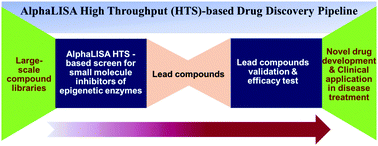当前位置:
X-MOL 学术
›
Mol. Biosyst.
›
论文详情
Our official English website, www.x-mol.net, welcomes your feedback! (Note: you will need to create a separate account there.)
Development of an AlphaLISA high throughput technique to screen for small molecule inhibitors targeting protein arginine methyltransferases
Molecular BioSystems Pub Date : 2017-10-25 00:00:00 , DOI: 10.1039/c7mb00391a Lakshmi Prabhu 1, 2, 3 , Lan Chen 2, 3, 4, 5, 6 , Han Wei 1, 2, 3 , Özlem Demir 3, 7, 8, 9, 10 , Ahmad Safa 1, 2, 3 , Lifan Zeng 2, 3, 4, 5, 6 , Rommie E. Amaro 3, 7, 8, 9, 10 , Bert H. O’Neil 2, 3, 6, 11 , Zhon-Yin Zhang 2, 3, 5, 6 , Tao Lu 1, 2, 3, 5, 6
Molecular BioSystems Pub Date : 2017-10-25 00:00:00 , DOI: 10.1039/c7mb00391a Lakshmi Prabhu 1, 2, 3 , Lan Chen 2, 3, 4, 5, 6 , Han Wei 1, 2, 3 , Özlem Demir 3, 7, 8, 9, 10 , Ahmad Safa 1, 2, 3 , Lifan Zeng 2, 3, 4, 5, 6 , Rommie E. Amaro 3, 7, 8, 9, 10 , Bert H. O’Neil 2, 3, 6, 11 , Zhon-Yin Zhang 2, 3, 5, 6 , Tao Lu 1, 2, 3, 5, 6
Affiliation

|
The protein arginine methyltransferase (PRMT) family of enzymes comprises nine family members in mammals. They catalyze arginine methylation, either monomethylation or symmetric/asymmetric dimethylation of histone and non-histone proteins. PRMT methylation of its substrate proteins modulates cellular processes such as signal transduction, transcription, and mRNA splicing. Recent studies have linked overexpression of PRMT5, a member of the PRMT superfamily, to oncogenesis, making it a potential target for cancer therapy. In this study, we developed a highly sensitive (Z′ score = 0.7) robotic high throughput screening (HTS) platform to discover small molecule inhibitors of PRMT5 by adapting the AlphaLISA™ technology. Using biotinylated histone H4 as a substrate, and S-adenosyl-L-methionine as a methyl donor, PRMT5 symmetrically dimethylated H4 at arginine (R) 3. Highly specific acceptor beads for symmetrically dimethylated H4R3 and streptavidin-coated donor beads bound the substrate, emitting a signal that is proportional to the methyltransferase activity. Using this powerful approach, we identified specific PRMT5 inhibitors P1608K04 and P1618J22, and further validated their efficacy and specificity for inhibiting PRMT5. Importantly, these two compounds exhibited much more potent efficacy than the commercial PRMT5 inhibitor EPZ015666 in both pancreatic and colorectal cancer cells. Overall, our work highlights a novel, powerful, and sensitive approach to identify specific PRMT5 inhibitors. The general principle of this HTS screening method can not only be applied to PRMT5 and the PRMT superfamily, but may also be extended to other epigenetic targets. This approach allows us to identify compounds that inhibit the activity of their respective targets, and screening hits like P1608K04 and P1618J22 may serve as the basis for novel drug development to treat cancer and/or other diseases.
中文翻译:

开发AlphaLISA高通量技术以筛选靶向蛋白质精氨酸甲基转移酶的小分子抑制剂
蛋白质精氨酸甲基转移酶(PRMT)酶家族包括哺乳动物中的九个家族成员。他们催化精氨酸甲基化,组蛋白和非组蛋白的单甲基化或对称/不对称二甲基化。PRMT的底物蛋白甲基化可调节细胞过程,例如信号转导,转录和mRNA剪接。最近的研究已将PRMT5(PRMT超家族的成员)的过表达与肿瘤发生相关联,使其成为癌症治疗的潜在靶标。在这项研究中,我们开发了一个高度灵敏(Z '分数= 0.7)的机器人高通量筛选(HTS)平台,通过采用AlphaLISA™技术来发现PRMT5的小分子抑制剂。使用生物素化的组蛋白H4作为底物,以及S-腺苷-大号-甲硫氨酸作为甲基供体,PRMT5在精氨酸(R)3上对称地二甲基化H4。用于对称二甲基化H4R3的高特异性受体珠和链霉亲和素包被的供体珠与底物结合,发出与甲基转移酶活性成比例的信号。使用这种强大的方法,我们确定了特定的PRMT5抑制剂P1608K04和P1618J22,并进一步验证了它们抑制PRMT5的功效和特异性。重要的是,这两种化合物在胰腺癌细胞和结直肠癌细胞中均显示出比市售PRMT5抑制剂EPZ015666更有效的功效。总体而言,我们的工作重点介绍了识别特定PRMT5抑制剂的新颖,功能强大且灵敏的方法。这种HTS筛查方法的一般原理不仅可以应用于PRMT5和PRMT超家族,但也可以扩展到其他表观遗传学目标。这种方法使我们能够鉴定出抑制其各自靶标活性的化合物,而筛选结果(例如P1608K04和P1618J22)可作为治疗癌症和/或其他疾病的新药开发的基础。
更新日期:2017-11-21
中文翻译:

开发AlphaLISA高通量技术以筛选靶向蛋白质精氨酸甲基转移酶的小分子抑制剂
蛋白质精氨酸甲基转移酶(PRMT)酶家族包括哺乳动物中的九个家族成员。他们催化精氨酸甲基化,组蛋白和非组蛋白的单甲基化或对称/不对称二甲基化。PRMT的底物蛋白甲基化可调节细胞过程,例如信号转导,转录和mRNA剪接。最近的研究已将PRMT5(PRMT超家族的成员)的过表达与肿瘤发生相关联,使其成为癌症治疗的潜在靶标。在这项研究中,我们开发了一个高度灵敏(Z '分数= 0.7)的机器人高通量筛选(HTS)平台,通过采用AlphaLISA™技术来发现PRMT5的小分子抑制剂。使用生物素化的组蛋白H4作为底物,以及S-腺苷-大号-甲硫氨酸作为甲基供体,PRMT5在精氨酸(R)3上对称地二甲基化H4。用于对称二甲基化H4R3的高特异性受体珠和链霉亲和素包被的供体珠与底物结合,发出与甲基转移酶活性成比例的信号。使用这种强大的方法,我们确定了特定的PRMT5抑制剂P1608K04和P1618J22,并进一步验证了它们抑制PRMT5的功效和特异性。重要的是,这两种化合物在胰腺癌细胞和结直肠癌细胞中均显示出比市售PRMT5抑制剂EPZ015666更有效的功效。总体而言,我们的工作重点介绍了识别特定PRMT5抑制剂的新颖,功能强大且灵敏的方法。这种HTS筛查方法的一般原理不仅可以应用于PRMT5和PRMT超家族,但也可以扩展到其他表观遗传学目标。这种方法使我们能够鉴定出抑制其各自靶标活性的化合物,而筛选结果(例如P1608K04和P1618J22)可作为治疗癌症和/或其他疾病的新药开发的基础。


























 京公网安备 11010802027423号
京公网安备 11010802027423号